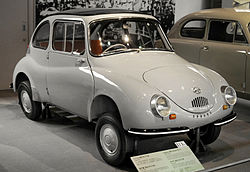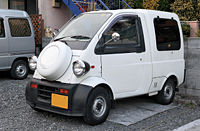| FAQ |
| Calendar |

 |
|
|||||||
| Mobil Wadah berkumpulnya pecinta, hobby, pemilik Mobil. |
 |
|
|
Thread Tools |
|
#1
|
||||
|
||||
|
This thread are dedicated to all fans of Kei Cars and will be updated with some pictures from the net(well.... eventually  ). so enjoy! ). so enjoy!  ============================  What is K-Car ? Kei car (K-car), also called keijidōsha (in Japanese: 軽自動車 light motor vehicle), is a Japanese category of small automobiles, including passenger cars, vans and pickup trucks. They are designed to exploit local tax and insurance relaxations, and are exempted from the requirement to certify that adequate parking is available for the vehicle. These standards originated in the times following the end of the Second World War, when most Japanese could not afford a full-sized car yet had enough to buy a motorcycle. To promote the growth of the car industry, as well as to offer an alternative delivery method to small business and shop owners, Kei car standards were created.  private car use  commercial car use The cars feature yellow licence plates, earning them the name "yellow-plate cars" in English-speaking (black numbers on yellow background for private use and yellow numbers on black background for commercial use) and spanish circles . Because the regulations only restrict physical size and engine power, manufacturers have introduced many advanced technologies to the class. As a result, kei cars are often available with forced induction engines, automatic and CVT transmissions, front-, rear- and four-wheel drive, hybrid drivetrains, air conditioning, GPS and many other features. Vans & Pickup trucks ? As I said, they are designed to exploit local tax and insurance relaxations, and are exempted from the requirement to certify that adequate parking is available for the vehicle. FYI most of roadways in Japan are quite smaller than any asian countries.   But they have similar name though, the pickup trucks are popular as Keitora (軽トラ) in Japan alongside their van version twin, the microvan are known as mian bao che ("bread loaf van") in China because of their shape. In a similar fashion, in several Latin American countries these vehicles are called Pan de Molde, which means "bread loaf". Why did the Japs make this kind of joke ? I'm not saying these cars is a joke if I were you... you see, these cars originated in the times following the end of the Second World War, when most Japanese could not afford a full-sized car yet had enough to buy a motorcycle. To promote the growth of the car industry, as well as to offer an alternative delivery method to small business and shop owners, kei car standards were created.  They originally limited to a mere 150 cc (100 cc for two-strokes) in 1949, dimensions and engine size limitations were gradually increased (in 1950, 1951, and 1955) to tempt more manufacturers to produce kei cars. It wasn't until the 1955 change to 360 cc as the upper limit for two-strokes as well as four-strokes that the class really began taking off, with cars from Suzuki (Suzulight) and then Subaru 360 finally able to fill people's need for basic transportation without being too severely compromised. Didn't these car having 0.6 litres engine with some gizmos and stuffs ? Yes, but they were having 0.5 engines also... It all started from the 70s, sales had been steadily declining, reaching a low water mark of 150,000 passenger kei cars in 1975, eigthy percent less than 1970 sales. Many were beginning to doubt the continued existence of the Kei car, with both Honda and Mazda withdrawing in the middle of the seventies. The even stricter emissions standards which were to be introduced in 1975 as part of a staggered program of cleaning the air proved problematic for kei manufacturers. This was particularly hard for Daihatsu and Suzuki who focused on two-stroke engines. Tiny Suzuki was worst off, with their entire production consisting of two-stroke engined kei cars. Daihatsu, on the other hand, had both the engineering backing and powerful connections of their large owner Toyota to aid them in meeting the new requirements. All manufacturers of kei cars were clamoring for relaxing the dimension conditions, claiming that the emissions standards could not be met with a functional 360 cc engine (even though Subaru's SEEC-T equipped Rex proved it possible). In the end, the Japanese legislature relented, increasing the overall length and width restrictions by 200 mm and 100 mm respectively. Engine size was increased to 550 cc, taking effect from January 1, 1976. Most manufacturers were somewhat surprised by the decision: having expected a 500 cc limit, they had already developed new engines to fit such restrictions. These new engines were quickly introduced, usually mounted within widened bodies of existing models. These interim versions (with displacements ranging between 443 and 490 cc) were "feelers", developed to see if there was indeed a continued market for the Kei car. As sales improved, they only lasted for a model year or so until manufacturers had had the time to develop "full-size" engines. Only Daihatsu managed to avoid developing transitional engine versions which did not take full advantage of the new regulations. Kei car sales remained stagnant however; while combined passenger and commercial Kei car sales reached 700,000 for the first time since 1974,[10] in a quickly growing market the small cars still lost market share. I see... and what about the 0.6 litres then ? In March 1990, new standards were again introduced. An extra 110 cc were now allowed in a slightly larger (10 cm longer) bodyshell. These changes came at a time when the Japanese economy was booming, so all manufacturers quickly developed new models to suit. The only 550 cc model to continue to be available for a while was the Mitsubishi Minica Dangan, which was only upsized five months later. As a response to ever increasing power, a limit of 64 PS (47 kW) was also added. 64 PS happened to be the highest outputs to have been reached at the time, it is unknown if there are any other reasons that this number was selected. ......... Terkait:
|
 |
|
|